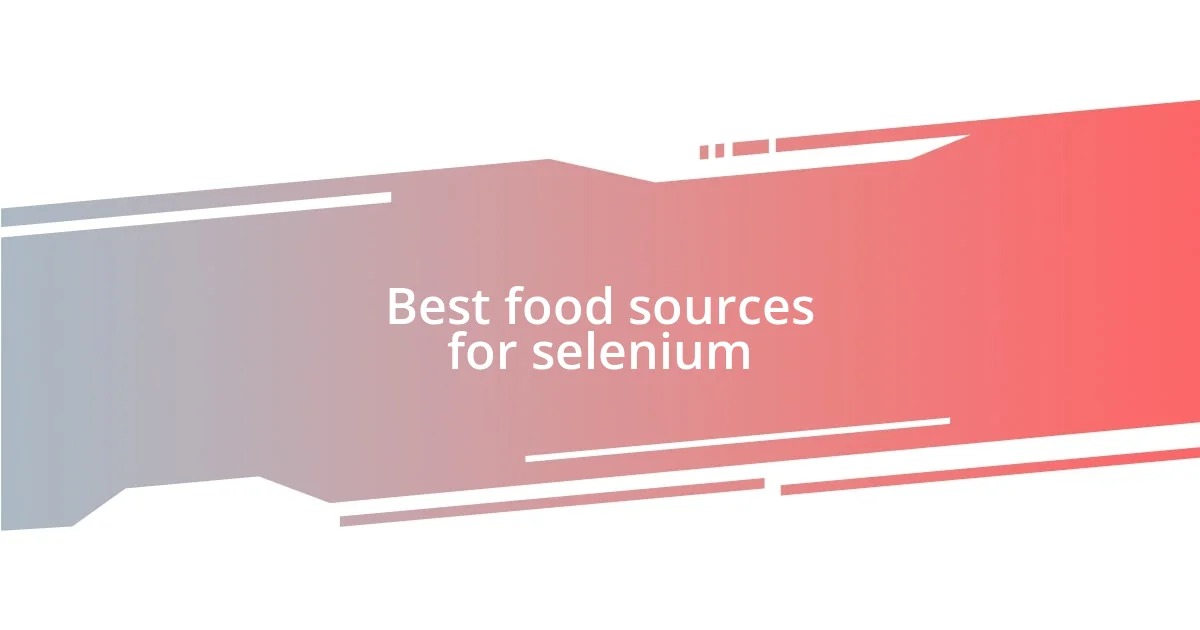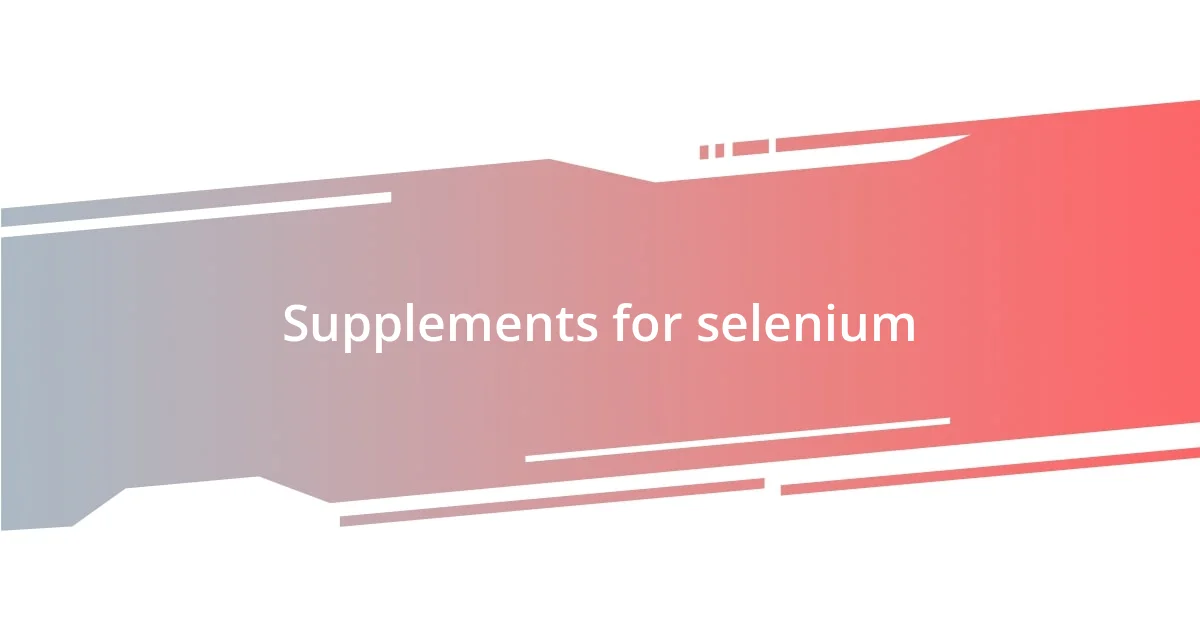Key takeaways:
- Selenium is crucial for immune function, thyroid health, and may reduce cancer risks; it’s important to include selenium-rich foods in your diet.
- Top sources of selenium include Brazil nuts, seafood (like tuna and sardines), whole grains, and lentils; adults should aim for 55 µg per day.
- Cooking methods like steaming, baking, and roasting preserve selenium, and monitoring levels through blood tests or food diaries helps maintain adequate intake.

Understanding selenium’s importance
Selenium is a trace mineral that plays a crucial role in our health, mainly due to its powerful antioxidant properties. I remember when I first learned about its importance while reading about immune function; it hit me how vital these tiny components are for keeping viruses at bay. Have you ever thought about how something so small can have such a big impact on our well-being?
One fascinating aspect of selenium is its connection to thyroid health. I once had a friend who struggled with thyroid issues, and it was eye-opening to discover that selenium deficiency can lead to complications. This made me realize how vital it is to ensure that we’re getting enough of this mineral, especially if our diets are lacking in selenium-rich foods like Brazil nuts or seafood.
Furthermore, selenium might aid in reducing the risk of certain cancers, which is something many of us worry about. I recall a health seminar I attended where experts discussed the potential protective effects of selenium; it sparked a sense of hope in many attendees. Isn’t it incredible how a small change in our diet could potentially make such a significant difference in our health journey?

Best food sources for selenium
When it comes to the best food sources for selenium, Brazil nuts are at the top of the list. Just a handful of these nuts can provide more than enough of this essential mineral for the day. I still remember the first time I tried Brazil nuts—crunchy and rich, they were a delightful surprise and a simple way to boost my selenium intake.
Seafood is another fantastic source of selenium, particularly fish like tuna, sardines, and halibut. I’ve found that incorporating seafood into my meals not only serves my taste buds but also gives me a hefty dose of nutrients, including selenium. It’s funny how a delicious meal can double as a health booster; I often feel more energized after a seafood dinner.
My experiences have taught me that whole grains and lentils can also contribute to our selenium needs. Though the amounts are lower than in nuts and fish, consuming a varied diet helps cover all bases. I remember experimenting with quinoa and lentil salads, feeling proud that I was not only creating something tasty but also looking after my health. Nutrition doesn’t have to be boring, right?
| Food Source | Selenium Content (µg per 100g) |
|---|---|
| Brazil Nuts | 1917 |
| Sardines | 90 |
| Tuna | 63 |
| Halibut | 47 |
| Brown Rice | 19 |
| Lentils | 6 |

Daily selenium intake recommendations
To meet daily selenium intake recommendations, the average adult should aim for about 55 micrograms (µg) per day. This requirement can vary depending on factors like age and gender, but I find that being aware of these numbers helps me stay on track with my nutrition. Whenever I plan my meals, I visualize this target, almost like a little challenge to incorporate selenium-rich ingredients.
Here’s a quick breakdown of selenium intake recommendations:
- Adult Men: 55 µg/day
- Adult Women: 55 µg/day
- Pregnant Women: 60 µg/day
- Breastfeeding Women: 70 µg/day
For me, the best part about focusing on my selenium intake is discovering the diverse foods that contribute. Recently, I decided to track my servings of selenium-rich foods for a week, and I was pleasantly surprised by how effortlessly I hit the mark with delicious meals. It’s quite rewarding to see how simple changes to my diet can make such a big impact, and I genuinely feel better knowing I’m nourishing my body correctly.

Recipes rich in selenium
One of my go-to recipes for boosting selenium is a hearty quinoa salad. I love mixing cooked quinoa with roasted sweet potatoes, spinach, and a scattering of chopped Brazil nuts for that satisfying crunch. You’d be amazed by how such a vibrant combination not only looks beautiful on the plate but also packs a nutritious punch—just savoring the flavors makes me feel like I’m nourishing my body in the best way possible.
Another simple yet delightful dish is a pan-seared tuna steak with a side of sautéed greens. The first time I made this, I was impressed by how quickly it came together. Tuna is such an incredible source of selenium, and as it cooked to a perfect medium-rare, the aroma filled my kitchen, instantly elevating my mood. Pair it with some garlic and lemon—it’s a dish that makes healthy eating feel indulgent, don’t you think?
For a family-friendly option, I often whip up a mixed seafood stir-fry. I toss in shrimp, scallops, and sardines with a variety of colorful bell peppers and broccoli. The first time my kids tried this, they couldn’t believe how delicious it was, and I felt like a culinary superhero. Not only do they get their selenium fix, but they also leave the table happy and satisfied, which is the ultimate win in my book.

Cooking methods that preserve selenium
When it comes to preserving selenium in my meals, cooking methods play a crucial role. I’ve found that steaming vegetables is one of the best techniques. The gentle heat helps maintain the nutrients without leaching them out, allowing me to enjoy my broccoli or asparagus while reaping all the selenium benefits. Have you ever tried steamed veggies with a squeeze of lemon? It’s a simple yet vibrant combo that truly shines!
Another method I often use is baking or roasting. I love roasting garlic and Brussels sprouts together; the flavors meld beautifully, and I get to keep the selenium intact. Unlike boiling, where selenium can wash away in the water, roasting captures the essence of the food. Sometimes, I wonder how I ever lived without that fragrant allure wafting through my kitchen—it’s almost comforting, isn’t it?
I tend to shy away from frying because I find it can destroy some of the selenium content due to high temperatures. However, if I must, I opt for quick sautéing over a high flame with a short cooking time. This method seems to balance the need for flavor and nutrition, allowing me to enjoy my dishes while keeping an eye on health. Does anyone else feel the satisfaction of cooking with intention? It’s a rewarding experience that connects me more deeply with the food I prepare.

Supplements for selenium
Sometimes, I find myself grappling with the idea of whether to rely solely on food sources for selenium or to incorporate supplements. After all, there are moments when my diet just doesn’t meet my nutritional needs. I’ve discovered that selenium supplements can be a convenient option, especially when life gets busy or if I’m not consistently consuming selenium-rich foods.
When I started taking a selenium supplement, I noticed subtle shifts in my energy levels. It was as if my body was responding to that little boost. There are different forms available, like selenomethionine and sodium selenite, and I opted for selenomethionine because it’s known for better absorption. Have you ever felt that sense of reassurance when you’re doing something good for your health? That’s what I experienced every morning as I took my supplement with breakfast.
It’s essential to remember that moderation is key. Too much selenium can lead to toxicity, so I always make it a point to talk with my healthcare provider before starting any new supplement regimen. I can’t help but wonder how many people overlook that simple, yet vital step. It’s such a small conversation that can yield significant benefits in ensuring I’m not just guessing at what’s right for my body.

Monitoring selenium levels effectively
Monitoring selenium levels effectively is more than just a numerical game; it’s about understanding how my diet interacts with this essential mineral. I’ve found blood tests to be a reliable way to track my selenium levels. It’s a straightforward process that offers clarity and insight into whether I’m hitting the right marks. Have you ever felt uncertain about your nutrient intake? Getting that little lab result can really put your mind at ease.
Another method I’ve embraced is keeping a food diary. This practice allows me to see patterns in my eating habits and identify which meals offer that vital selenium boost. By jotting down my meals, I not only stay accountable but also get a clear glimpse into my dietary choices. It’s like having a personal nutritionist right by my side! Have you ever tried this approach? It’s eye-opening how such a simple action can reveal so much about your nutrition.
Lastly, I can’t stress enough the importance of working with a healthcare provider. Collaborating with a professional has provided me guidance tailored to my unique needs. Together, we evaluate my dietary intake and supplement choices, ensuring I’m not going off track. Does anyone else appreciate how empowering it feels to have expert support along the nutritional journey? It’s a partnership that enhances my understanding and commitment to my health.













